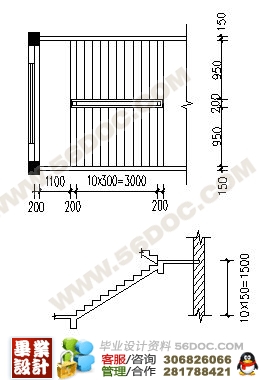摘 要本设计位于武昌主干道、珞瑜路旁,交通方便,东侧邻一马路及商场,南靠珞瑜路,西侧及北侧为开发性用地,发展前景良好。主要分为二阶段:建筑设计、结构设计。
第一阶段是建筑设计,根据建筑设计的依据以及建筑设计的基本原则,对结构进行功能分区,进一步确定工程的平面、立面以及剖面。
第二阶段是结构设计。主要是梁柱的截面设计,具体步骤是对某一榀横向框架进行框架的结构计算和设计,即在确定的计算简图的基础上,通过对水平荷载和竖向的计算得出梁柱的最不利内力组合,并以次为设计依据来确定梁柱的截面尺寸和所需钢筋的截面面积。除对梁柱的设计外,还需要设计一部楼梯,一个柱下独立基础。其中内力计算中竖向荷载作用下的内力计算采用分层法,水平荷载作用下的内力计算采用D值法。本工程除了手算部分,还采用建筑软件PKPM进行计算。
本设计的主要成果为毕业设计说明书一份、施工图 16张
关键词:设计 结构 框架 D值法 PKPM
Abstract
The design which is a project,located the main road of Wuchang Area,beside Luoyu Road ,transportation convenience.On east side,there are a street and a market,the south is Luoyu Road,west and north side is developing ground,development the foreground is good.Comprise of two parts: The architectural design, structure design .
The first part of design is about architectural design. According to architectural design basis as well as architectural design basic principle, carreies on the function district to the structure, further determines the project the plane, the vertical surface as well as the section plane.
The second part of design is about structural design. Mainly is carries on the beam column section design .The concrete step is carryes on a crosswise frame the structure computation and the design ,namely in the definite computation diagram foundation, and the design, through obtains the beam column to the horizontal load and the vertical computation the most disadavantageous endogenic force combination, and take this as design basis detemined the beam column the section size and required reinforcement in the area of cross section . Besides to beam column design, but also needs to design a stair and a independent stratification method; in the horizontal direction, we use D method. In addition to the parts calculated by hands,we adopt an architecture software PK-PM to calculate.
Our production contains an instruction book of graduation
Theris and sixteen pieces of shop drawing
Key words: design structure frame D method PKPM
建筑设计的基本内容
建筑设计的基本内容包括空间环境的组合设计和建筑空间环境的构造设计.其中空间环境的组合设计包括:建筑总平面设计﹑建筑平面设计(平面面积﹑交通比例的分配)﹑建筑剖面设计(空间比例的分配)建筑立面的设计.空间环境的结构设计主要包括构件的设计﹑材料的选择以及构造方法.
建筑设计总说明
工程概况
1. 建设地点:武昌主干道﹑珞瑜路旁,交通方便,东侧邻一马路及商场,南靠珞瑜路,西侧及北侧为开发性用地,发展前景良好.
2.工程性质:本工程为住宅楼建筑.建筑层7层,总长度58.8m,总宽度11.7m,总建筑面积约5000㎡.
3.结构形式:框架结构,住宅内设有A﹑B两个户型,分别为两室两厅( 65.9m2 )﹑三室两厅(108.6m2).
4.合理使用年限为50年.
5.本设计图纸除注明外,尺寸以毫米为单位,标高以米为单位.所有屋面等有防水层的板面,其标高均指结构板面.
设计资料
1.设计标高:室内设计标高±0.000,室内外高差为450㎜.
2.墙部分:
1)外墙均为200㎜的加气混凝土砌块砖,内墙均为150mm的加气混凝土砌块砖,M7.5混合砂浆.
2)内墙粉刷为20㎜石灰砂浆底,纸筋灰罩面,外刷胶漆埋内。外墙粉刷为20㎜厚1:3水泥砂浆底,彩色水刷石抹面。
3)凡墙上留洞见建筑图,钢筋混凝土墙或楼板留洞详见结构图。
4)配电箱﹑消火栓﹑水表墙面留洞,一般洞深与墙厚相等,背面均做钢板网粉刷,钢板网四周应大于200宽。
3.楼面做法:楼板顶面为20㎜厚水泥砂浆找平,30㎜花岗石贴面;顶棚采用15㎜石灰砂浆打底,纸筋灰罩面,外刷乳胶漆。
4.屋面做法:现浇楼板上铺膨胀珍珠岩保温层(天沟处厚100㎜,以2%坡度自两侧天沟向中间找坡),然后是1:2水泥砂浆找平层20㎜,二毡三油防水并撒绿豆砂保护。
5.门窗做法:主要为防盗门﹑胶合板门。窗均用铝合金窗。
1)除注明外,一般木门开启方向与墙面平齐。
2)铝合金窗玻璃采用5厚无色透明玻璃,铝合金门采用6厚的无色透明玻璃。
3)设计图中门窗立面分格均未考虑施工安装尺寸。
6.雨篷做法:
上部为20㎜防水砂浆抹面,下部为纸筋灰顶棚。
7.地质资料:
地下水平均水位低于室内地面以下2.5m,地耐力为350Kpa,地震烈度为6度。
8.基本风压: =0.25KN∕ .
9.活荷载:
上人屋面:2.0KN/㎡;
楼面均布活荷载:2.0KN/㎡;
挑出阳台:2.5 KN/㎡;
厕所、楼房;2.0 KN/㎡;
基本雪压:0.4KN/㎡。
10.细部做法:
所有露明铁件均涂防锈漆一度,上刷油漆二度;木门均做底油一遍,调和油二遍;屋面排水均采用PVC落水管,雨水管、弯头直径D=100㎜;混凝土柱内预埋 6墙体拉结钢筋2根,每隔500㎜拉通。
根据设计方案,初步选定梁柱的尺寸:框架梁取b=250㎜,h=600㎜;次梁取b=200㎜,h=400㎜;柱截面均为b*h=400㎜*400㎜;现浇楼板厚100㎜;基础顶面离室外地面为500㎜。
结构选型:
1.结构体系选型:采用钢筋混凝土现浇框架结构(纵横向承重框架)体系。
2.其他结构选型:
1)屋面结构:采用现浇钢筋混凝土屋面板作承重结构,屋面板按不上人屋面的使用荷载选用。
2)楼面结构:采用现浇钢筋混凝土楼面板作承重结构。
3)楼梯结构:采用现浇钢筋混凝土整体板式楼梯。
4)天沟:采用现浇及膨胀珍珠岩勾勒而成。
5)过梁:窗过梁以及带雨蓬的门过梁,并采用纵向框架梁兼作窗过梁。
6)基础梁:采用现浇钢筋混凝土基础梁。
7)基础:采用钢筋混凝土现浇柱下独立基础。
设计资料:
工程概况:建筑总高为24.95m,共7层,每层层高3.0m,室内外高差0.45m。


目 录
摘要••••••••••••••••••••••••••••••••••••••••••••••••••••••••••4
第一篇 建筑设计部分••••••••••••••••••••••••••••••••••••••••••6
第二篇 结构设计部分••••••••••••••••••••••••••••••••••••••••••8
第一章 结构设计说明••••••••••••••••••••••••••••••••••••••8
第二章 结构选型与结构布置••••••••••••••••••••••••••••••••9
第三章 框架计算••••••••••••••••••••••••••••••••••••••••••10
第四章 框架梁、柱截面配筋计算••••••••••••••••••••••••••••38
第五章 基础计算••••••••••••••••••••••••••••••••••••••••••49
第六章 楼梯计算••••••••••••••••••••••••••••••••••••••••••51
第三篇 PKPM计算结果•••••••••••••••••••••••••••••••••••••••54
结语••••••••••••••••••••••••••••••••••••••••••••••••••••••••••65
参考文献 •••••••••••••••••••••••••••••••••••••••••••••••••••••66 |

